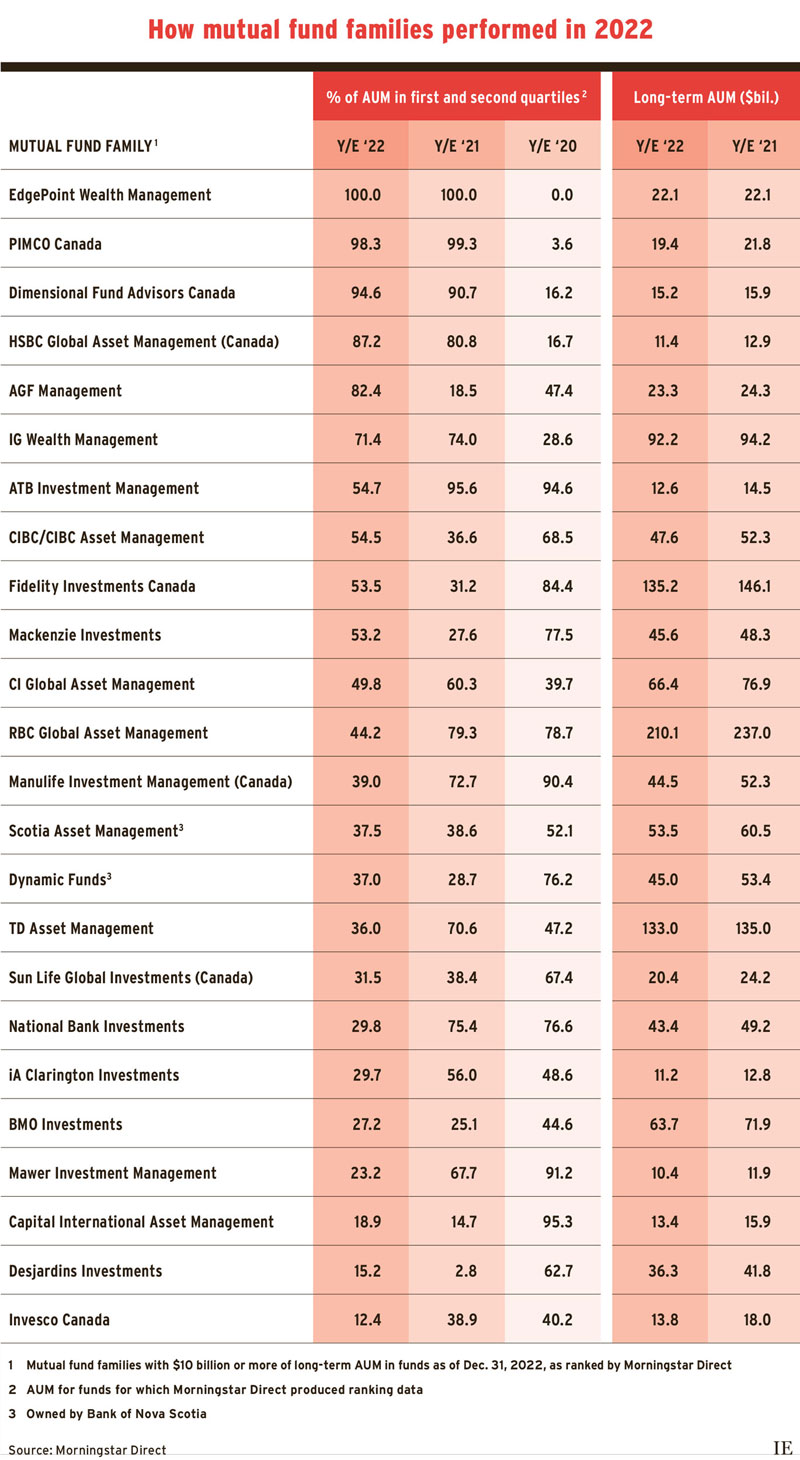
This article appears in the February 2023 issue of Investment Executive. Subscribe to the print edition, read the digital edition or read the articles online.
Equities and fixed income dropping in tandem last year surprised a lot of investors, including those managing mutual fund families.
“Expectations were for a relatively benign environment with moderate interest rate hikes as inflation eased. But inflation didn’t decelerate and central banks were very aggressive,” said Jim Huggan, chief investment officer (CIO) with HSBC Global Asset Management (Canada) Ltd.
Last year’s tough investing environment meant most HSBC funds had negative returns, but the fund family’s performance was better than that of many of its peers, with 87.2% of assets under management (AUM) held in funds that ranked in the first or second quartile (thus yielding above-average returns), according to Chicago-based Morningstar Direct.
HSBC ranked fourth after EdgePoint Wealth Management Inc., which saw all its funds yield above-average returns, PIMCO (98.3% of funds in the first or second quartile) and Dimensional Fund Advisors Canada Inc. (94.6%). AGF Management Ltd. ranked fifth (82.4%) and IG Wealth Management ranked sixth (71.4%).
AGF and IG both used liquid alternative investments. Jon Kilfoyle, senior vice-president with IG Investments, said private investments also were helpful.
But not everyone is enthusiastic about liquid alts. “You don’t want the cost to outweigh the benefit,” warned Brett Kimak, president of ATB Investment Management Inc. (its families placed seventh).
Private investments tend to have lower volatility than public ones because they attract less speculation. But Kimak said valuations on private investments occur less frequently than for public holdings, so “you don’t get a great perspective” on how the businesses are doing.
Here’s a look at some fund families in more detail:
EdgePoint Wealth Management
All five of its ranked funds were first-quartile. The EdgePoint Canadian Growth and Income Portfolio, an aggressive allocation equity balanced fund, and the EdgePoint Canadian Portfolio, a large-cap fund, both had positive returns in 2022.
“Our focus is delivering performance at or near the top of our peer group over 10 years,” said Tye Bousada, partner and co-founder.
PIMCO Canada
One of the major reasons for the fund family’s strong performance relative to its peers in 2022 was its holdings of non-agency mortgage-backed securities issued before the global financial crisis, said Alfred Murata, managing director and portfolio manager. During the year, PIMCO, which focuses on fixed income, also picked up agency mortgage-backed securities that became available when the Fed rolled them off its balance sheet.
Dimensional Fund Advisors of Canada
On the equities side, fund managers stick to a disciplined approach focused on small caps, stocks with low price-to-book ratios, and profitable companies (measured by EBITDA minus interest payments divided by book value), said Mary Phillips, deputy head of portfolio management for North America. All fixed income is invested globally with a focus on the most attractive expected returns, as measured by yield curves and credit spreads, and all funds are hedged to the local currency of unitholders.
HSBC Global Asset Management (Canada)
Huggan attributed the firm’s results partly to asset allocation at the beginning of last year, and partly to profit-taking and selective purchases during the year.
The HSBC fund family began with a significant overweight in Canadian equities and ended with only a slight overweight. The family also began with short duration for many of its fixed-income holdings, allowing it to replace these with higher-yielding securities as interest rates rose.
The spread between government and corporate bonds didn’t narrow much in Canada last year, but did elsewhere. Huggan said this could result in gains when the Canadian spreads narrow in 2023.
Equities valuations are “quite attractive,” Huggan said, opening the door for stock-picking within sectors this year.
AGF Management
This fund family minimized losses by “being disciplined and very conservative, sitting on more cash than usual, underweighting fixed income and using some liquid alternatives,” said Kevin McCreadie, CEO and CIO.
The AGFiQ US Market Neutral Anti-Beta CAD-Hedged ETF, for example, employs an equities hedge designed to lower portfolio volatility and reduce the impact of drawdowns. The ETF is long on low-beta U.S. equities and short an equal basket of the highest-beta U.S. stocks. “The performance spread between these two groups can generate a positive return, even in a negative market,” McCreadie said. AGF managers used AGF’s real assets fund and its liquid global infrastructure ETF to protect against inflation, with the infrastructure fund also providing income.
McCreadie said he anticipates the first half of 2023 to be “very choppy. … Equity markets will now struggle with weakening economic data, which could lead to a recession and dampen profits,” he said.
In general, AGF funds began 2023 overweight in U.S. and Japanese equities, underweight in Canadian and European stocks, and neutral to slightly overweight in emerging-market equities.
IG Wealth Management
Kilfoyle said IG’s managers use long/short strategies for currency exposure as well as for fixed income and equities, with the latter mainly U.S.-focused.
The company also offers the IG Mackenzie Real Property Fund, which is available only to IG clients. The fund isn’t ranked by Morningstar because there aren’t enough, if any, equivalents, but it returned more than 10% in 2022.
Kilfoyle anticipates a shallow recession. He said equities are probably troughing and that valuations favour international and emerging markets, especially as China relaxes its Covid restrictions. He noted that a post-recession environment usually favours small caps.
ATB Investment Management
Kimak said the ATB fund family benefited from a rotation to value investing. Returns were pulled down slightly by underweights in energy and an overweight in Europe. Tech, where ATB avoids “high flyers,” was positive.
This year ATB is pushing up the quality of its credit investments, Kimak said, and still favouring short duration. He said this puts it in a good position regardless of what happens to interest rates.
Fidelity Investments Canada
Kelly Creelman, senior vice-president, products and marketing, said a lot of Fidelity’s value managers outperformed, but that 2022 was a tough year for growth managers. On the fixed income side, floating-rate debt and U.S. Treasury inflation-protected securities held up well.
Creelman said investor sentiment became more balanced at the end of 2022, but odds are elevated that volatility will continue, especially in the first half of the year.
TD Asset Management
David Sykes, CIO and head of investments, called 2022 an “incredibly difficult environment where everyone was surprised, including central banks.” He noted that tech stocks were hit hard because their future cash flows had to be discounted, given the big increase in interest rates. If recession is avoided and there’s a soft landing, Sykes thinks there could be 3%–5% returns in equities this year.
Mawer Investment Management
This stock-picking firm has often posted strong outperformance, but 2022 wasn’t a good environment. Mawer also held tech stocks and didn’t have much exposure to oil and gas. However, the fund family continued to find quality companies with the resiliency to bounce back after downturns, said Paul Moroz, Mawer’s CIO.
In 2022, Mawer portfolio managers initiated a position in XP Inc., an online brokerage firm based in Brazil that is strongly increasing its market share. They also added to holdings of Brembo SpA, an Italy-based designer, manufacturer and seller of automotive braking systems that’s developing a system that uses electronics, not hydraulics.
Desjardins Investments
Jean-François Girard, manager of mutual and guaranteed funds development, said the fund family’s relatively weak performance was mainly due to its ESG focus. Desjardins invests little in fossil fuels or weapon manufacturing. The fund family didn’t benefit from the strength in energy, the only major sector with positive returns. Nor did it benefit from increased demand for arms due to the war in Ukraine.
About 25% of the fund family’s AUM is held in funds with ESG mandates, but the remaining are expected to apply minimum ESG standards.
Click image for full-size chart
